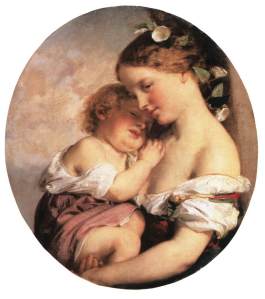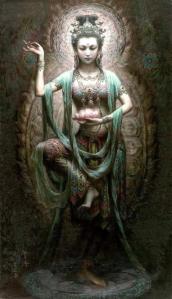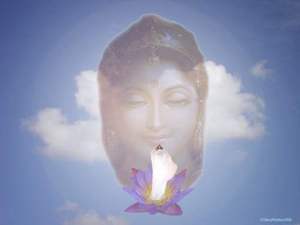 What is “mother,” really? I have had to come to grips with the term in recent times as I have chosen to suffer less as a biological mother who gestated a fertilized ovum for 10 months. Not nine; 10. The doctor said then, in 1972, there was a term for this: hyperactivity. Intuitively, I took on the role of attachment parenting to gain mutual sensitivity so that my child would grow up caring, so that she would be quietly alert.
What is “mother,” really? I have had to come to grips with the term in recent times as I have chosen to suffer less as a biological mother who gestated a fertilized ovum for 10 months. Not nine; 10. The doctor said then, in 1972, there was a term for this: hyperactivity. Intuitively, I took on the role of attachment parenting to gain mutual sensitivity so that my child would grow up caring, so that she would be quietly alert.
It was a high- touch style of parenting; she needed that, because she had been kept from me for three days. I cried, “Where is my baby? Why haven’t they brought her to me,” when seeing that the other mothers in the ward had theirs.
How I feared I would have an unconnected child. Could I settle for a semi-bonded child—somewhat wired enough to be able to control her hyperactivity, distractability, and impulsivity? I had had to become her advocate because she was gifted, like her maternal grandfather, in mathematics. She and I both survived as daughter and mother on a roller coaster for years. Only recently, have I looked at my role as mother now that she is highly independent and capable with many tools under her belt.
There are perhaps five types of mothers—the unreliable-inconstant mother; the insecure mother, the best-friend mother, the perfectionist mother; and lastly, the complete mother. It is the last one who leaves the best legacy of motherhood and is much needed. This ideal mother is only had by about 10 percent of the population; and it is very likely that this is one reason why the role of mother in American society is viewed with apathy, mixed feelings, or outright rejection.
With this in mind, I seek to understand the historical mother as Universal Memory. Who or what is She in the Collective, or better yet, Universal Unconsciousness? I will seek her from a gestalt, eastern point of view; and, hopefully, my internal mental process, starting with Mt. Everest.
You ask incredulously, “Mt. Everest!? I ask you what does Mt. Everest mean to you?
Mountains have symbolically represented constancy, eternity, firmness, and stillness. In some ancient traditions, the mountain was associated with sun, rain, and thunder coming from the gods. In much earlier traditions, it was the feminine, earth herself including Mt. Everest, an image of intense and enduring polar coldness. It is a desert of ice and snow, a barren place. At a spiritual level, mountains portray full consciousness—completeness. For those climbing Mt. Everest, the mountain may or may not be considered sacred or an aspiration to renounce worldly desires. The Sherpas, however, come from such a tradition of sacredness. They understand the perils lurking there; yet they call her “Holy Mother”: Chomolungma.
This geographical name first appeared in a 1733 map published in Paris by French geographer D’Anville, but it had appeared even earlier in a 1719 Chinese map. Under the British Colonial Empire, Col. Sir George Everest, Surveyor-General of India, wanted the highest mountain in the world to be named after him. Since he found the indigenous name distasteful, he opposed its use and ardently complained to the Royal Geographical Society in 1857. They did so 11 years later.
And what have we given her in return? Traffic-jams by summiteers, life-threatening thefts, plenty of litter, and over 200 dead frozen bodies strewn within the death zone of this sacred ground! How barren is the commercialized soul.
Chomolungma, the local Tibetan name, can be traced back to the Tibetan Bön deity, Miyolangsangma, “Virtuous One of Inexhaustible Giving.” What does She give? The obvious is that, in her stateliness, She gives life from her womb. The not so obvious is that She represents the cycle of life and death and the in-between space.
In the RigVega (when writing about an early Iron Age (10th c. B.C.E.)), Mother Earth is Prithvi Mata which means “That Which Holds Everything,” and was addressed along with “Father Sky” to connote the idea of two complementary half-disks. She was viewed as provider, sustainer, and enricher. Ah. And it was She who dispelled Mara’s challenge to deny Buddha his accomplishment and attested that Gautama Siddhartha Shakyamuni’s worthiness of his awakening; Mother, his witness). The canons show that She was not the embodiment of all unskillful emotions, that She was not to blame for the ceaseless round of birth and death, that She was not responsible for the entirety of conditioned existence, and that Mara was a male energy engaged in wielding dysfunctional power. However, She was knotted with the “do nots.”
The Great Mother tradition survived in Buddhism and is reflected in the Ekayāna sutras (teachings) that traces “Ma” back to pre-Buddhist times. Though deeply hidden in the archaic layers of consciousness, “Ma” is part of an important title, “Lama,” which means “Supreme Mother.” Even in recent times the patriarchal mindset attempts to revise its translation erroneously (i.e., High Priest). In another invaluable teaching about mother, Buddhism holds that everyone has been one’s mother at least once over the eons. Thus, one should reflect on the loving care and compassion one’s mother has given a child. It is a practice for a follower of the Buddha Dharma to cultivate “loving kindness, compassion, equanimity, and joy.”
From the beginning of Buddhism there was a notion of the underlying feminine principle. Buddhist texts have rich inter-textual allusion to Mother. For example, Prajnaparamita (“The Perfection of Transcendent Wisdom”) is said to be “The Mother of the Buddhas” or “The Womb of the Tathagatas.” The primary matrix of existence is called “Mother of Creation.” The Mother principle is the space that gives birth both to all Buddhas and to the phenomenal world. She is the ongoing process of existence. Given these points, “Mother” means “Essence of the Buddhas.” “Light” is also called “Emptiness” or “Void.” Because “Light” is born out of “darkness, there is something beyond “Emptiness.” True Mother is “Emptiness beyond Emptiness.”
At some point, there was a search to overcome the cycle of birth and death. In time, patriarchy was established and the attributes of the Great Mother or the Mother as the Vacuum—the Cosmic Womb—the Void—the Origin of Light–receded. The patriarch did not want to be second fiddle in social or cultural matters. Politically, She was blamed for the cycle of life and death; and it was hidden from the consciousness as the in-between space—existence itself (i.e., the emptiness or voidness where all things happen, including enlightenment). Mother is “Darkness from Which the Light (Buddhahood) Originates.” Without Her there is no enlightenment, no new creation.
Machig Lapdron, an enlightened yogini (1055-1145) in her luminous state of clarity, heard Tara, a female Buddha-Bodhisattva, say—
“Listen, yogini, your past is cleared from your heart; but I will explain it to you. The Great Mother is the void state of all the dharmas which we call Mother of all Creation. The Mother is the Mother of the Buddhas of the Three Times, the Dharmata of the Absolute State, beyond all obstructions, the pure essence of egoless voidness-Prajna“ or the Lotus which is the Womb.
oooooooooo
Mother, including Father, is everywhere. We just have to look and then choose the best model—the complete mother who knows her boundaries. She is an equal and She is named as equal in the Aramaic translation of the King James’s Lord’s Prayer—Abwoon d’bwashmaya[1]. Jesus of Nazareth in uttering abwoon wanted us to go beyond the concepts of “male” and “female” to a cosmic birthing process—vibrating forth creative breath from Oneness which shines light into every center we see and every center of activity so that potential abilities of all things can be seen. She is matter, he is spirit; and together they became the cosmos and manifested as us, co-creators of our Teytey malkutttthakh within (i.e., our kingdom and queendom). The words in Aramaic translate to “I can” walk the in-between space of the naked nature of phenomenal existence where darkness welcomes the dawn. It is a force that seems to bind and define the space between the particles of an atom. Some call that invisible force love. Some call it the Theory of Higgs Boson.
Who was it that introduced mother as whore? The Chaldeans, the Hebrews, the early Christians? No one knows or remembers. It came into consciousness as a religious condemnation of conflicting cultures. The Whore of Babylon or “Babylon the Great” is used as a Christian allegory for evil in the “Book of Revelation” where the vehemous term of a “Christian” zealot survives: “Babylon the Great, the Mother of Prostitutes and Abominations of the Earth”–cause for “Jehovean” enmity to prevail throughout the centuries. Keeping it in historical context, when the “Book of Revelation” was written by John of Patmos, in exile under the persecution of the Roman emperor Domitian, Rome was considered Babylon, the new pagan state.
As for me, the role of mother is still difficult, especially to engage in mental assertiveness, a form of emotional detachment. But it is time. This clarity looks directly into my face.00000000000000000
Relinquish the past and don’t be fearful of the present or the future. Engage in positive thinking and form the highest principles as a true human being, resolving the dichotomies. It reveals this suchness—be the equal measures of acceptance, understanding, and appreciation.
But it doesn’t end here. Let’s write UNESCO Headquarters in Paris, France, petitioning that Mt. Everest be reclaimed as Chomolungma, or Shengmu Feng in traditional Chinese (“Holy Mother”), for She no longer tolerates anything unclean on Her mountain. As for the Nepalese name (Sagamatha (the “Head in the Great Blue Sky”)) for the mountain range, it is a misnomer; and we don’t want any more denying of the Holy Mother. As an Earth and Water Type, She personifies much depth, seriousness, and a strong, positive sense of self-protectiveness in all activities—to maintain and obtain resources, and to endure any calamity. And, watch out for the dichotomies, in other words, duality! See the concepts for what they are and release them when you can.
In supplication to all mothers–past, present, and future, go gently into Mother space to softly touch whatever it is and then let go completely.
May all Mother’s hearts be cleared from the past.
||||||||||||||||||||||||||||||||||
[1] Prayers of the Cosmos, Meditations on the Aramaic Words of Jesus, translated with commentary by Neil Douglas-Klotz and forward by Matthew Fox
0000000000000
000000000000http://www.youtube.com/watch?v=uTtyBJTstVk
000000000000



Pingback: A Welcoming Engagement « Though 4 Thought